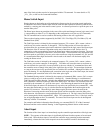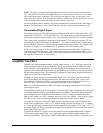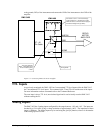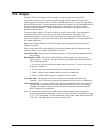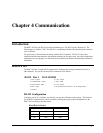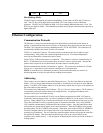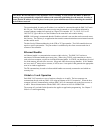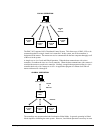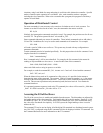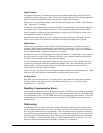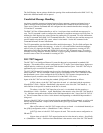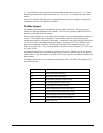
44 • Chapter 4 Communication DMC-3425
OFF ON 1200
Handshaking Modes
The RS232 port is configured for hardware handshaking. In this mode, the RTS and CTS lines are
used. The CTS line will go high whenever the DMC-3425 is not ready to receive additional
characters. The RTS line will inhibit the DMC-3425 from sending additional characters. Note: The
RTS line goes high for inhibit. This handshake procedure ensures proper communication especially at
higher baud rates.
Ethernet Configuration
Communication Protocols
The Ethernet is a local area network through which information is transferred in units known as
packets. Communication protocols are necessary to dictate how these packets are sent and received.
The DMC-3425 supports two industry standard protocols, TCP/IP and UDP/IP. The controller will
automatically respond in the format in which it is contacted.
TCP/IP is a "connection" protocol. The master must be connected to the slave in order to begin
communicating. Each packet sent is acknowledged when received. If no acknowledgement is
received, the information is assumed lost and is resent.
Unlike TCP/IP, UDP does not require a "connection". This protocol is similar to communicating via
RS232. If information is lost, the controller does not return a colon or question mark. Because the
protocol does not provide for lost information, the sender must re-send the packet.
Ethernet communication transfers information in ‘packets’. The packets must be limited to 470 data
bytes or less. Larger packets could cause the controller to lose communication.
NOTE: In order not to lose information in transit, Galil recommends that the user wait for an
acknowledgement of receipt of a packet before sending the next packet.
Addressing
There are three levels of addresses that define Ethernet devices. The first is the Ethernet or hardware
address. This is a unique and permanent 6 byte number. No other device will have the same Ethernet
address. The DMC-3425 Ethernet address is set by the factory and the last two bytes of the address are
the serial number of the controller.
The second level of addressing is the IP address. This is a 32-bit (or 4 byte) number. The IP address is
constrained by each local network and must be assigned locally. Assigning an IP address to the
controller can be done in a number of ways.
The first method is to use the BOOT-P utility via the Ethernet connection (the DMC-3425 must be
connected to network and powered). For a brief explanation of BOOT-P, see the section: Third Party
Software. Either a BOOT-P server on the internal network or the Galil terminal software may be used.
To use the Galil BOOT-P utility, select the registry in the terminal emulator. Next, select the DMC-
3425 controller communicating via Ethernet from the software registry. Once the controller has been
selected, the next screen shows options for the actual connection. Enter the IP address at the prompt
and select either TCP/IP or UDP/IP as the protocol. When done, click on the ASSIGN IP ADDRESS.
The Galil Terminal Software will respond with a list of all controllers on the network that do not
currently have IP addresses. The user selects the controller and the software will assign the controller
the specified IP address. Then enter the terminal and type in BN to save the IP address to the
controller's non-volatile memory. A full description of addressing the card may be found in Chapter 2
Getting Started.





